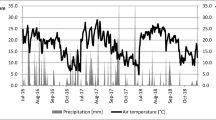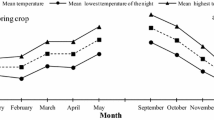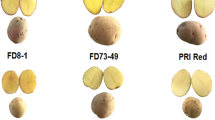Abstract
Bromoethane was evaluated for its suitability to induce dormant tubers to sprout. Bromoethane immediately broke dormancy and caused multiple sprouting when applied to whole tubers as a vapor at 0.1 or 0.2 ml/L for 24 h at room temperature. Superficial and localized necrosis developed on the tubers if proper skin set had not occurred either in the field or after a curing period. In fall greenhouse trials, bromoethane treatment of whole tubers of the cultivars Red Pontiac, Russet Burbank, Bintje, Kennebec and Caribe induced them to sprout 40 to 70% earlier than untreated controls. Application of bromoethane significantly increased the mean rate of shoot elongation by 2.8 mm/day although there was no significant difference in its effect among the cultivars.
Resumen
Se evaluó el bromoetano por su capacidad para inducir brotamiento de tubérculos en dormancia. El bromoetano rompió la dormancia inmediatamente e indujo brotamiento múltiple cuando se aplicó a tubérculos enteros en forma de vapor a 0.1 ó 0.2 ml/L por 24 h. a temperatura ambiental. Se produjo necrosis superficial y localizada en los tubérculos que no habían formado piel en el campo, o bajo condiciones de almacenaje. En experimentos de invernadero durante el otoño, el tratamiento con bromoetano de tubérculos enteros de los cultivares Red Pontiac, Russet Burbank, Bintje, Kennebec y Caribe, indujo brotamiento del 40 a 70%, antes que los testigos. La aplicación de bromoetano incrementa significativamente la tasa media de alargamiento del tallo en 2.8 mm/día, aunque no hubo ninguna diferencia significativa en su afecto entre los cultivares.
Similar content being viewed by others
Literature Cited
Barber, E.D., W.H. Donish and K.R. Mueller. 1981. A procedure for the quantitative measurement of the mutagenicity of volatile liquids in the Ames Salmonella/microsome assay. Mutat Res 90:31–48.
Burton, W.G. 1978. Post-harvest behaviour and storage of potatoes.In. Applied Biology (T.H. Coaker, ed.) vol. 111, pp. 86–228, Academic Press, London.
Denny, F.E. 1926a. Hastening the sprouting of dormant potato tubers. Am J Bot 13:118–125.
Denny, F.E. 1926b. Second report on the use of chemicals for hastening the sprouting of dormant potato tubers. Am J Bot 13:386–396.
Denny, F.E. 1926c. Effect of thiourea upon bud inhibition and apical dominance of potato. Bot Gaz 81:297–311.
Denny, F.E. 1945. Synergistic effects of three chemicals in the treatment of dormant potato tubers to hasten germination. Contrib Boyce Thompson Inst 14:1–20.
Department of Health, Education and Welfare. 1978. Ethylene oxide, ethylene chlorohydrin and ethylene glycol. Federal Register 43:27474–27483.
Guthrie, J.D. 1939. Role of glutathione in the breaking of the rest period of buds by ethylene chlorohydrin. Contrib Boyce Thompson Inst 11:261–270.
Juodeika, L.F. 1981. National Toxicology Program, Dept. of Health and Human Services, Bethesda, MD, personal communication.
Lewis, Sr., R.J. (ed.) 1978. Registry of Toxic Effects of Chemical Substances. U.S. Dept. of Health, Education and Welfare, Washington, D.C.
McCallum, W.B. 1909. Twentieth Ann Rep Univ Arizona Agric Exp Stn, pp. 584–586.
Miller, L.P. 1933. Effect of sulphur compounds in breaking the dormancy of potato tubers and in inducing changes in the enzyme activities of the treated tubers. Contrib Boyce Thompson Inst 5:29–81.
Miller, L.P. 1934. The effect of the alkyl halides on the respiration of potato tubers. Contrib Boyce Thompson Inst 6:279–296.
Poirier, L.A., G.D. Stoner and M.B. Shimkin. 1975. Bioassay of alkyl halides and nucleotide base analogs by pulmonary tumor response in strain A mice. Cancer Res 35:1411–1415.
Rosa, J.T. 1923. Abbreviation of the dormant period in potato tubers. Proc Am Soc Hortic Sci 1923:180–187.
Sax, N.I. 1979. Dangerous Properties of Industrial Materials. Van Nostrand Reinhold Co., New York.
Spector, W.S. (ed.). 1956. Handbook of Toxicology. Vol. 1: 336–337.
Thornton, N.C. 1933. Carbon dioxide storage. V. Breaking the dormancy of potato tubers. Contrib Boyce Thompson Inst 5:471–481.
Thornton, N.C. 1938. Oxygen regulates the dormancy of the potato. Contrib Boyce Thompson Inst 10:339–361.
Author information
Authors and Affiliations
Rights and permissions
About this article
Cite this article
Coleman, W.K. An evaluation of bromoethane for breaking tuber dormancy inSolanum tuberosum L.. American Potato Journal 60, 161–167 (1983). https://doi.org/10.1007/BF02853997
Received:
Issue Date:
DOI: https://doi.org/10.1007/BF02853997




